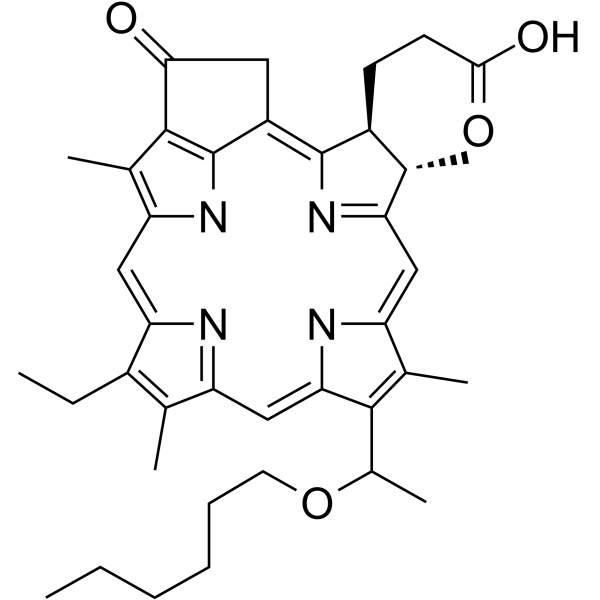上海金畔生物科技有限公司为生命科学和医药研发人员提供生物活性分子抑制剂、激动剂、特异性抑制剂、化合物库、重组蛋白,专注于信号通路和疾病研究领域。
HPPH (Synonyms: Photochlor) 纯度: 99.73%
HPPH (Photochlor) 是第二代光敏剂,用于光动力疗法 (PDT)。

HPPH Chemical Structure
CAS No. : 149402-51-7
| 规格 | 价格 | 是否有货 | 数量 |
|---|---|---|---|
| 10 mM * 1 mL in DMSO | ¥2942 | In-stock | |
| 5 mg | ¥2100 | In-stock | |
| 10 mg | ¥3400 | In-stock | |
| 25 mg | ¥6800 | In-stock | |
| 50 mg | ¥9900 | In-stock | |
| 100 mg | 询价 |
* Please select Quantity before adding items.
HPPH 相关产品
•相关化合物库:
- Drug Repurposing Compound Library Plus
- Clinical Compound Library Plus
- Bioactive Compound Library Plus
- Anti-Cancer Compound Library
- Clinical Compound Library
- Drug Repurposing Compound Library
- Rare Diseases Drug Library
| 生物活性 |
HPPH (Photochlor) is a second generation photosensitizer, which acts as a photodynamic therapy (PDT) agent. |
||||||||||||||||
|---|---|---|---|---|---|---|---|---|---|---|---|---|---|---|---|---|---|
| 体外研究 (In Vitro) |
Fluorescence image of 4T1 cells incubated with 0.49 µg/mL GO-PEG, 1 μM HPPH (free HPPH) or equivalent amount of GO-PEG-HPPH (1 µM HPPH and 0.49 µg/mL GO-PEG) after 24 h. The cellular uptake of GO-PEG-HPPH and HPPH is investigated with 4T1 murine mammary cancer cells. The cells are incubated with GO-PEG-HPPH and free HPPH at equivalent HPPH concentration (1 µM) for 24 h and then observed with a confocal microscope. Cells treated with GO-PEG-HHPH shows stronger fluorescence signal than those treated with free HPPH. In fact, the fluorescence of HPPH is rather weak[1]. 上海金畔生物科技有限公司 has not independently confirmed the accuracy of these methods. They are for reference only. |
||||||||||||||||
| 体内研究 (In Vivo) |
Tumors are treated with an immune-enhancing PDT regimen followed by a tumor-controlling PDT regimen can leads to enhancement of anti-tumor immunity, while retaining effective control of primary tumor growth. To test this hypothesis, a combination treatment regimen is devised in which Colo26-HA tumor-bearing BALB/c mice are treated with a HPPH-PDT regimen known to lead to enhanced anti-tumor immunity (0.4 μmoles/kg HPPH followed 18 h later by illumination with 665 nm light for a total dose of 48 J/cm2). Following illumination, mice are rested for 9 days; on the ninth day, mice are injected with HPPH. On day 10 following the first treatment, tumors are treated with a tumor control treatment regimen (illumination with 665 nm light for a total dose of 132 J/cm2 given)[2]. 上海金畔生物科技有限公司 has not independently confirmed the accuracy of these methods. They are for reference only. |
||||||||||||||||
| Clinical Trial |
|
||||||||||||||||
| 分子量 |
636.82 |
||||||||||||||||
| Formula |
C39H48N4O4 |
||||||||||||||||
| CAS 号 |
149402-51-7 |
||||||||||||||||
| 运输条件 |
Room temperature in continental US; may vary elsewhere. |
||||||||||||||||
| 储存方式 |
4°C, sealed storage, away from moisture and light *In solvent : -80°C, 6 months; -20°C, 1 month (sealed storage, away from moisture and light) |
||||||||||||||||
| 溶解性数据 |
In Vitro:
DMSO : 125 mg/mL (196.29 mM; Need ultrasonic) 配制储备液
*
请根据产品在不同溶剂中的溶解度选择合适的溶剂配制储备液;一旦配成溶液,请分装保存,避免反复冻融造成的产品失效。 In Vivo:
请根据您的实验动物和给药方式选择适当的溶解方案。以下溶解方案都请先按照 In Vitro 方式配制澄清的储备液,再依次添加助溶剂: ——为保证实验结果的可靠性,澄清的储备液可以根据储存条件,适当保存;体内实验的工作液,建议您现用现配,当天使用; 以下溶剂前显示的百
|
||||||||||||||||
| 参考文献 |
|
| Cell Assay [1] |
4T1 cells are cultured in 96-well cell culture plates at 1×104/well for 24 h and then treated with GO-PEG-HPPH, HPPH, or GO-PEG at a series of concentrations (0.078125, 0.15625, 0.3125, 0.625, 1.25, 2.5, 5, 10, and 20 μM). Then, 20 µL of MTT solution (5.0 mg/mL) is added to each well. After the 4 h incubation with the MTT, the media are removed and 100 µL of DMSO is added to solubilize the formazan crystals. The cell toxicity efficacy is measured with a microplate reader at an absorbance of 570 nm[1]. 上海金畔生物科技有限公司 has not independently confirmed the accuracy of these methods. They are for reference only. |
|---|---|
| Animal Administration [2] |
Mice[2] 上海金畔生物科技有限公司 has not independently confirmed the accuracy of these methods. They are for reference only. |
| 参考文献 |
|
所有产品仅用作科学研究或药证申报,我们不为任何个人用途提供产品和服务
